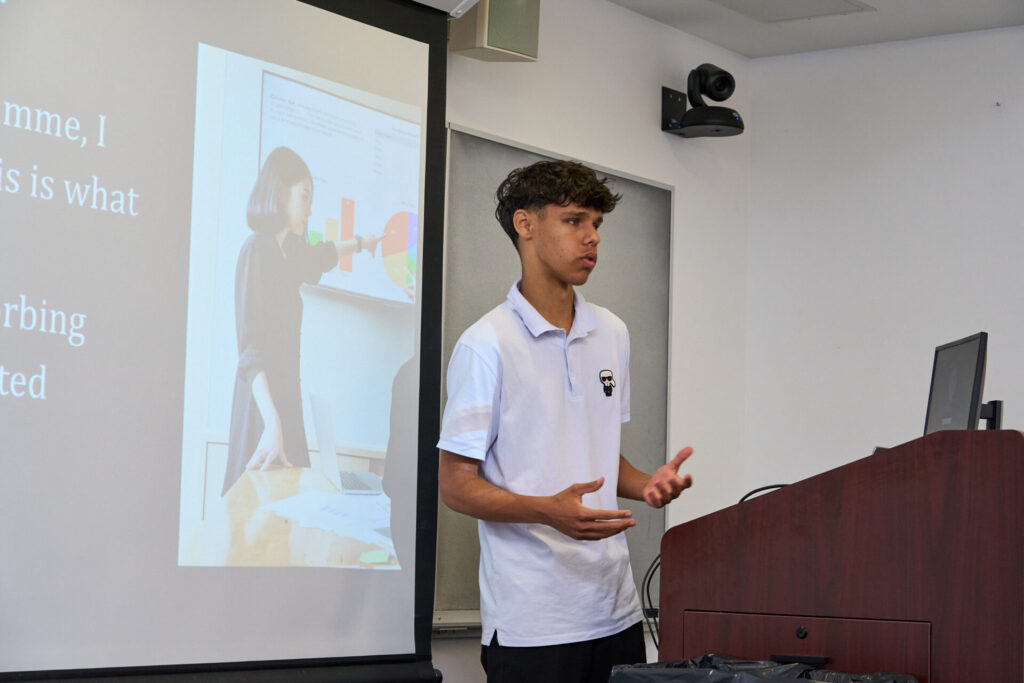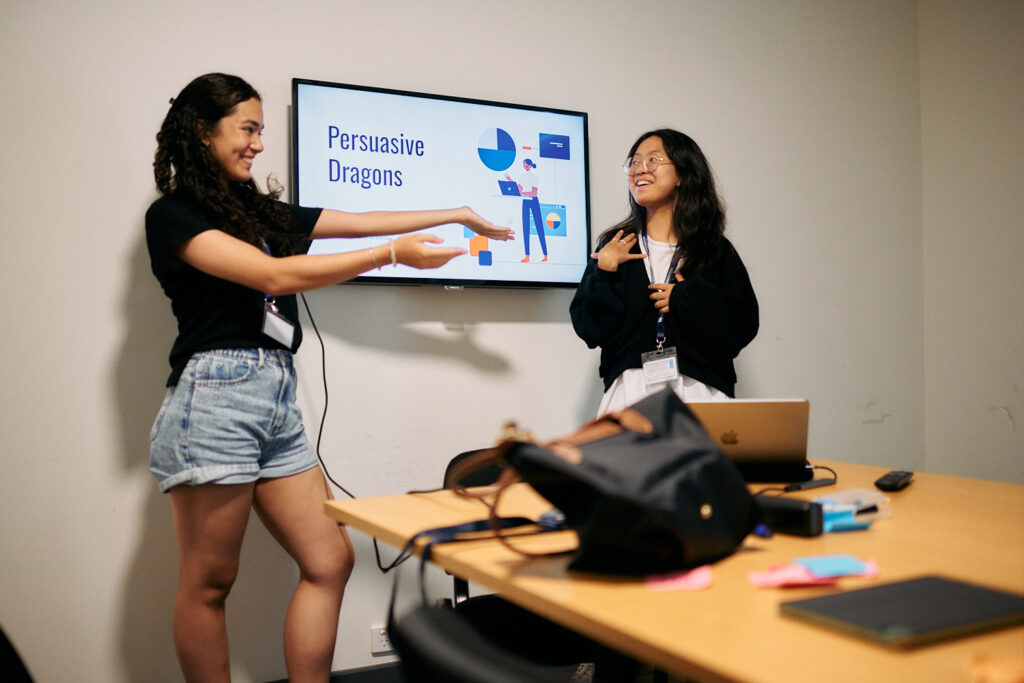“Leadership is not about being in charge. It is about taking care of those in your charge.” – Simon Sinek. Learning how to improve leadership skills begins with understanding that true influence is built on empathy and trust.
Leadership is not a position; it is a mindset. It is the ability to inspire, guide, and empower others toward shared goals. You might be able to remember a time that you persuaded a group to take a specific course of action or helped your friend gain the confidence to take a next step – that was you being a leader, and you didn’t need a title!
Through experience in our TED Summer School, you will explore how communication, confidence, and purpose shape the leaders of tomorrow.
Let us begin by defining what leadership truly means and how you can start developing these qualities today.
What Is Leadership?
Leadership is the ability to influence, guide, and inspire others toward a shared purpose. It begins not with authority but with awareness of yourself, your values, and the people around you.
Unlike management, which focuses on processes, leadership is about people. It involves vision, empathy, and the courage to make decisions that create collective progress.
A longitudinal study of 1,048 employees across 90 work teams found that when leaders adopted an engaging leadership style that motivated, enabled, and connected others, team effectiveness increased significantly. The study revealed that trust, communication, and participation were key to this improvement.
A great leader listens before leading. They communicate clearly, support others’ growth, and help individuals recognise their own potential. Through that process, they earn trust rather than demand it.
In schools, communities, and future workplaces, leadership shapes how ideas become action. It is what turns teamwork into transformation.
Through reflection and collaboration, you start to see leadership as a service, an act of enabling others to succeed while growing yourself.
Leadership vs Management – What’s the Difference?
Leadership and management share a common goal: achieving results through people. Yet they approach that goal in very different ways.
A leader focuses on vision, inspiration, and influence. They create purpose and motivate others to move toward it. A manager focuses on structure, efficiency, and execution. They organise people and resources to ensure goals are achieved effectively.
Leadership is about why we do something. Management is about how we get it done. Leaders imagine possibilities; managers turn those ideas into action. Both are essential for success.
Leaders empower; managers enable. Teams need both: the dreamer and the doer, the strategist and the organiser. In practice, one person can wear both hats – setting direction and structuring delivery – though not always at the same moment.
At work, leadership is a shared value: anyone can spark a vision and rally colleagues. Managers hold the accountability for turning that vision into plans, aligning people and resources, and reporting outcomes. In school, a project leader might define the theme and keep energy high, while another teammate coordinates tasks, deadlines, and quality – but those roles can rotate as the project moves from idea to execution.
Through experience in our TED Summer School, you will practise both roles, learning how inspiration and organisation work together to bring ideas to life. This balance prepares you to lead confidently in any setting, from classroom projects to future careers.
Why Leadership Skills Matter for Students
Leadership skills matter for students because they build confidence, communication, and collaboration, forming the foundation for success in study and beyond.
Learning how to improve leadership skills helps you think independently, solve problems creatively, and guide others with empathy and purpose.
These abilities prepare you for real-world challenges, from group projects to future careers, where teamwork and adaptability define success.
At Immerse Education’s London Summer School, you will apply these qualities in collaborative projects that strengthen your voice, vision, and confidence as a leader.
Leadership skills empower you to make a positive impact, turning potential into action and ideas into meaningful change.
5 Core Leadership Qualities to Develop
Strong leaders share a set of essential qualities that guide how they think, act, and connect with others.
Understanding these traits is key when exploring how to improve leadership skills and become a more empathetic, confident leader.
- Self-Awareness and Emotional Intelligence: Helps you understand your strengths and emotions while responding to others with empathy and balance. Builds thoughtful, authentic leadership.
- Empathy and Communication: Encourages trust through understanding and active listening. Strengthens collaboration and turns shared goals into meaningful teamwork.
- Accountability and Integrity: Means taking responsibility, acting honestly, and staying consistent. Creates credibility and earns lasting respect from others.
- Decision-Making and Vision: Combines logic, empathy, and creativity to guide progress. Involves others in choices to inspire trust and achieve shared goals.
- Confidence and Positivity: Promotes calm, focused leadership that motivates others and drives progress through optimism and purpose.
Join the Immerse Education 2025 Essay Competition
Follow the instructions to write and submit your best essay for a chance to be awarded a 100% scholarship.

How to Improve Leadership Skills (Step-by-Step)
Improving leadership skills takes time, reflection, and practice. Small, consistent actions help you build confidence, empathy, and clear communication.
Each step strengthens how you guide others, solve problems, and make decisions with purpose. Let’s explore simple, practical ways to grow as a leader.
1. Practise Self-Awareness and Reflection
Strong leadership starts with self-awareness. It’s about understanding your strengths, values, and the impact of your actions on others.
Reflection turns experience into growth. By taking time to assess what went well and what could improve, you develop clarity, authenticity, and emotional balance.
Research by Hartung (2020) in the Journal of Applied Leadership and Management found a strong positive correlation between leaders’ self-awareness and their teams’ motivation, satisfaction, and productivity. Leaders who regularly reflect on their actions are more effective and trusted by those they lead.
Building this habit of reflection helps you lead with empathy and confidence, turning self-knowledge into stronger relationships and better decisions.
2. Set Clear Goals and a Personal Vision
“Leadership is the capacity to translate vision into reality.” – Warren Bennis
Every great leader starts with a vision, a clear picture of where they want to go and why it matters. Setting specific, measurable goals helps you turn that vision into action, guiding your daily choices and long-term plans.
A strong personal vision aligns your ambitions with your values and the impact you want to create. It gives meaning to your efforts and helps others rally behind your purpose.
When you lead with clarity and intention, you inspire confidence not just in yourself but in everyone who follows your direction.
3. Communicate with Clarity and Confidence
Clear communication is at the heart of effective leadership. When learning how to improve leadership skills, focus on developing clarity and confidence in how you share ideas and inspire action.
Strong leaders express themselves with purpose and listen with genuine attention. They adapt their words to different audiences, using empathy and awareness to connect meaningfully.
Confidence comes from preparation and authenticity. The more clearly you understand your message, the more naturally you can share it with others.
When you communicate with clarity and conviction, people don’t just hear your words; they trust your direction and believe in your vision.
4. Lead by Example in Everyday Actions
True leadership begins with self-leadership. Before you can inspire others, you must hold yourself to the same standards you expect from them.
Everyday actions such as showing integrity, staying accountable, and following through define how people experience your leadership. What you model consistently becomes what others mirror.
In his TEDx Talk “Great Leadership Starts With Self-Leadership,” Lars Sudmann explains that the most effective leaders manage themselves first. They set the tone through self-awareness, discipline, and clarity of behaviour, proving that influence begins with example, not authority.
Leading by example is not about perfection. It is about consistency, doing what is right even when no one is watching, and showing others that leadership is lived through everyday choices.
5. Encourage Teamwork and Collaboration
What makes a great team thrive? It is not just talent but how people connect, communicate, and trust each other.
Great leaders know that success is never achieved alone. Collaboration turns individual strengths into collective achievement, and understanding how to improve leadership skills can help you create environments where teamwork truly thrives.
Encouraging teamwork means creating an environment where everyone feels valued, heard, and motivated to contribute. It starts with listening, sharing credit, and supporting open communication.
When you bring people together around a shared purpose, differences become strengths. Teamwork builds trust, resilience, and creativity that drive progress.
At Immerse Education, our programmes help participants practise these skills through real-world challenges, showing how effective collaboration leads to confident, empathetic leadership.
6. Cultivate Empathy and Emotional Intelligence
The strongest leaders are not defined by authority, but by their ability to understand and connect with others.
Empathy and emotional intelligence allow leaders to recognise emotions, listen deeply, and respond with compassion. These qualities build trust, reduce conflict, and foster stronger relationships across teams.
Leaders with emotional intelligence inspire loyalty and collaboration because they make people feel valued and understood. They lead with both heart and clarity, turning challenges into opportunities for growth.
Developing empathy is not about being agreeable; it’s about being aware. By understanding others, leaders create inclusive environments where everyone can thrive.
7. Learn from Experience and Continuous Feedback
Leadership isn’t mastered overnight; it’s shaped through reflection, mistakes, and growth. Interviewers will often ask about your biggest weakness or a time you failed – not to catch you out, but to see how you learn. The strongest answer owns the misstep, shows how you sought feedback, and proves what changed as a result.
Every challenge offers insight. Great leaders treat feedback not as criticism but as a compass. They listen, adapt, and evolve with each experience, showing that progress comes from awareness, not perfection. If you can say, “I missed the mark, asked for specific input, applied it, and here’s the improvement,” you move from apology to evidence – and that can make you a shoo-in.
Seeking feedback also builds trust. Inviting honest perspectives signals confidence and creates a culture where learning is shared and improvement is celebrated. Close the loop by describing the concrete action you took and the measurable outcome, even if small.
Continuous growth begins with curiosity and the willingness to ask, “What can I do better next time?” In interviews, that mindset turns a weakness into a story of responsibility, resilience, and results.
Popular Leadership Styles (and When to Use Them)
Everyone leads differently. A leadership “style” is just the way you guide a group—how you make decisions, motivate people, and organise the work.
Try on styles like outfits and see what fits the moment: go Transformational when you’re pitching a new idea or club change and need to inspire; use Transactional when a plan, deadlines, and checkpoints will keep a project (or revision schedule) on track; switch to Democratic when your group needs lots of ideas and buy-in; be Autocratic only when time is tight and someone has to decide fast; choose Servant when your priority is helping teammates shine (think mentoring, community projects); and use Situational as your overall “mix-and-match”, adjusting how much direction or support people need.
Ask for quick feedback after each role – what helped, what didn’t – and commit to one main style for each project so your team knows what to expect, then review and tweak it next time.
- Transformational Leadership: Inspires others through vision and shared purpose. Encourages creativity, motivation, and personal growth within a supportive, forward-thinking environment. Best for leading change or inspiring innovation.
- Transactional Leadership: Focuses on structure, accountability, and clear goals. Uses rewards and feedback to maintain progress and consistency. Most effective in organised settings where outcomes are easily measured.
- Democratic (Participative) Leadership: Involves the whole team in decision-making and values every idea. Builds trust, engagement, and collaboration. Ideal for group projects or creative problem-solving.
- Autocratic (Authoritarian) Leadership: Relies on clear direction and decisive action. Works best in time-sensitive or high-pressure situations that require strong organisation and quick thinking.
- Servant Leadership: Prioritises the needs of others and helps people reach their full potential. Promotes inclusion, empathy, and teamwork. Best for community-based or collaborative environments.
- Situational Leadership: Adapts leadership style based on team experience and confidence. Balances support and direction to match the situation. Effective for developing new teams or guiding peers with varied strengths.
Quick Quiz: What’s Your Leadership Style?
1. When your team faces a new project, what’s your first move?
a) Paint an exciting picture of what’s possible.
b) Set clear goals, timelines, and rewards.
c) Ask for everyone’s ideas before deciding.
d) Give firm instructions and delegate tasks quickly.
e) Find out what support or training people need.
f) Judge the situation first, then adjust your approach.
2. How do you motivate others?
a) By inspiring them with purpose and vision.
b) Through recognition, bonuses, or progress tracking.
c) By involving them in decisions and valuing their input.
d) By keeping strict focus and discipline.
e) By coaching and encouraging them personally.
f) By changing tone or tactics depending on their needs.
3. When deadlines are tight, how do you lead?
a) Remind the team why their work matters.
b) Tighten processes and check progress often.
c) Discuss priorities together to find solutions.
d) Take full control and issue clear directions.
e) Offer reassurance and practical help.
f) Provide more structure to less experienced teammates.
4. What kind of team culture do you aim for?
a) Creative and forward-thinking.
b) Organised and results-driven.
c) Collaborative and democratic.
d) Efficient and decisive.
e) Supportive and caring.
f) Balanced and adaptable.
5. How do you define success as a leader?
a) Inspiring growth and innovation.
b) Meeting every target consistently.
c) Building engagement and trust.
d) Achieving quick, clear results.
e) Helping others reach their potential.
f) Guiding the team effectively in any scenario.
Your Results
- Mostly A’s: Transformational Leader – you inspire change and creativity.
- Mostly B’s: Transactional Leader – you value structure and accountability.
- Mostly C’s: Democratic Leader – you lead through collaboration and inclusion.
- Mostly D’s: Autocratic Leader – you thrive in decisive, fast-paced settings.
- Mostly E’s: Servant Leader – you prioritise empathy, growth, and teamwork.
- Mostly F’s: Situational Leader – you adapt your style to fit every challenge.
Leadership Lessons from TED Speakers
Leadership grows stronger when grounded in courage, inclusivity, and vision.
These TED speakers illustrate how to improve leadership skills through empathy, awareness, and purpose, showing that great leadership always begins within.
June Sarpong: The Courage to Champion Inclusion
Broadcaster June Sarpong challenges you to use your influence to create opportunities for others.
In “We Need Leaders Who Boldly Champion Inclusion”, she reminds leaders that inclusion takes bravery. It means speaking up for fairness, even when it’s uncomfortable, and creating space for every voice to be heard.
By choosing inclusion over silence, you spark creativity, strengthen teamwork, and show that true leadership begins with empathy, respect, and collective courage.
Roselinde Torres: The Courage to Lead with Vision
Leadership expert Roselinde Torres invites you to think ahead and question the familiar.
In “What It Takes to Be a Great Leader”, she explains that visionary leaders dare to embrace change and diversity.
By asking challenging questions and seeking diverse perspectives, you prepare for the future with curiosity and confidence. Great leaders, she reminds us, see possibilities where others see obstacles and inspire others to see them too.
Lars Sudmann: The Courage to Lead Yourself First
Leadership consultant Lars Sudmann believes that effective leadership begins within.
His talk “Great Leadership Starts with Self-Leadership” teaches that courage means holding yourself accountable and acting consistently with your values.
When you practise discipline and reflection, you set a strong example for others to follow. Leading yourself with honesty, clarity, and purpose helps you build credibility and trust; the foundation on which every great leader stands and grows.
Together, these talks show that learning how to improve leadership skills is not about authority but about courage in action; facing emotion, embracing inclusion, thinking boldly, and leading yourself with purpose.
Conclusion
Strong leadership is not defined by titles but by the actions and attitudes that inspire others.
Learning how to improve leadership skills begins with self-awareness, empathy, and the courage to keep growing. These traits turn ordinary moments into opportunities for influence and progress.
At TED Summer School, participants explore these same ideas as they transform insight into impact through reflection, collaboration, and purposeful communication.
Leadership is a lifelong journey. The more you practise it with curiosity, confidence, and care, the more you empower others to succeed alongside you.


















